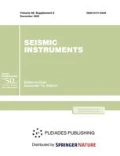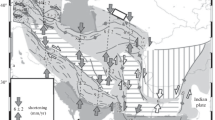Abstract
Based on literature data and original constructions of the focal mechanisms of earthquakes within the Romashkinskaya seismically active zone of the Tatar Arch for 1992–1995, additional information was obtained on the nature of the stress–strain state in the central Russian Platform, which is a “white spot” on the well-known world stress maps (WSM). Predominant subhorizontal uniaxial compression in the southeast–northwest direction is established, which is agrees well with the observed regional maximum horizontal stress field SHmax in Western Europe. As one of the possible reasons for this orientation of this compression, along with a plate tectonics interpretation, a system of planetary tectonic fracturing of rock material is proposed. This fracturing, in light of the ideas obtained here on the nature of the stress–strain state of the crust, can be understood as numerous planes of thrust and shear dislocations that formed during deformation of crustal material under horizontal compression in the indicated direction.







Similar content being viewed by others
REFERENCES
Aleinikov, A.L., Borovikov, V.F., Zubkov, A.V., and Kholevin, N.I., Geodynamics of the Urals from the data of real-scale and model studies, Geol. Geofiz., 1977, no. 2, pp. 156–158.
Beloborodov, D.E. and Tveritinova, T.Yu., Stress and strain fields of the East European Plate, Tezisy nauchnoi konferentsii “Lomonosovskie chteniya” (Abstracts of the “Lomonosov Readings” Scientific Conference), Moscow, Russia, 2004, Moscow: Mosk. Gos. Univ., 2004.
Brudy, M., Zoback, M.D., Fuchs, K., Rummel, F., Baumgartner, J., Estimation of the complete stress tensor to 8 km depth in the KTB scientific drill holes: Implications for crustal strength, J. Geophys. Res.: Solid Earth, 1997, vol. 102, pp. 18453–18475.
Gamkrelidze, I.P., Planetary-scale fracturing of dislocated strata and phenomena associated to it, Geotektonika, 1972, no. 6, pp. 45–54.
Gzovskii, M.V., Turchaninov, I.A., Markov, G.A., et al., Stress state of the Earth’s crust inferred from measurements in mine workings and tectonic analysis, in Napryazhennoe sostoyanie zemnoi kory (po izmereniyam v massivakh gornykh porod) (Stress State of the Earth’s Crust from Measurements in Rock Massifs), Kropotkin, P.N., Ed., Moscow: Nauka, 1973, pp. 32–49.
Hast, N., The state of stress in the upper part of the Earth’s crust, Tectonophysics, 1969, vol. 8, no. 3, pp. 169–211.
Hast, N., The state of stress in the upper part of the Earth`s crust as determined by measurements of absolute rock stress, Naturwissenschaften, 1974, vol. 61, no. 11, pp. 468–475.
Heidbach, O. and Höhne, J., CASMI – a tool for the visualization of the World Stress Map data base, Comput. Geosci., 2008, vol. 34, pp. 783–791. https://doi.org/10.1016/j.cageo.2007.06.004
Heidbach, O., Reinecker, J., Tingay, M., Müller, B., Sperner, B., Fuchs, K., and Wenzel, F., Plate boundary forces are not enough: Second- and third-order stress patterns highlighted in the World Stress Map database, Tectonics, 2007, vol. 26, no. 6. https://doi.org/10.1029/2007TC002133
Heidbach, O., Tingay, M., Barth, A., Reinecker, J., Kurfeb, D., and Müller, B., Global crustal stress pattern based on the World Stress Map database release 2008, Tectonophysics, 2010, vol. 482, nos. 1–4, pp. 3–15. https://doi.org/10.1016/j.tecto.2009.07.023
Heidbach, O., Rajabi, M., Reiter, K., and Ziegler, M., World Stress Map Database Release 2016, Potsdam: GFZ Data Services, 2016. https://doi.org/10.5880/WSM.2016.001
Heidbach, O., Custodio, S., Kingdon, A., Mariucci, M.T., Montone, P., Müller, B., Pierdominici, S., Rajabi, M., Reinecker, J., Reiter, K., Tingay, M., Williams, J., and Ziegler, M., Stress Map of the Mediterranean and Central Europe 2016, Potsdam: GFZ Data Service, 2016. https://doi.org/10.5880/WSM.Europe2016
Heidbach, O., Rajabi, M., Cui, X., Fuchs, K., Müller, B., Reinecker, J., Reiter, K., Tingay, M., Wenzel, F., Xie, F., Ziegler, M.O., Zoback, M.L., and Zoback, M.D., The World Stress Map database release 2016: Crustal stress pattern across scales, Tectonophysics, 2018, vol. 744, pp. 484–498.
Katterfel’d, G.I. and Charushin, G.V., Global-scale fracturing of the Earth and other planets, Geotektonika, 1960, no. 6, pp. 3–11.
Katterfel’d, G.I. and Charushin, G.V., The regional criterion of distinguishing the systems of planetary-scale fractures, in Davleniya i mekhanicheskie napryazheniya v razvitii sostava, struktury i rel’efa litosfery (Pressures and Mechanical Stresses in Development of Composition, Structure, and Relief of the Lithosphere), Leningrad: Nedra, 1969.
Katterfel’d, G.I. and Charushin, G.V., The regional criterion of distinguishing the systems of planetary-scale fractures, in Geodinamika, magmatizm i minerageniya kontinental’nykh okrain Severa Patsifiki: Materialy Vserossiiskogo soveshchaniya (“Geodynamics, Magmatism, and Minerageny of Continental Margins of the North Pacific,” Proceedings of the All-Russian Meeting), Magadan, 2003, vol. I, pp. 55–57.
Khain, V.E. and Lomize, M.G., Geotektonika s osnovami geodinamiki (Geotectonics with Fundamentals of Geodynamics), Moscow: Knizhnyi dom Universitet, 2010.
Kingdon, A., Fellgett, M.W., and Williams, D.O., Use of borehole imaging to improve understanding of the in-situ stress orientation of Central and Northern England and its implications for unconventional hydrocarbon resources, Mar. Pet. Geol., 2016, vol. 73, pp. 1–20. https://doi.org/10.1016/j.marpetgeo.2016.02.012
Korchemagin, V.A., Geological structure and stress fields with respect to the evolution the evolution of endogenous regimes in Donbass, Extended Abstract of the Doctoral (Geol.-Mineral.) Dissertation, Moscow, 1984.
Korchemagin, V.A. and Emets, V.S., Peculiarities of tectonic structure and stress field development in the Donbass and East Azov region, Geotektonika, 1987, no. 3, pp. 41–57.
Kropotkin, P.N., The results of stress state measurements in rocks of Scandinavia, West Europe, Iceland, Africa, and North America, in Napryazhennoe sostoyanie zemnoi kory (po izmereniyam v massivakh gornykh porod) (Stress State of the Earth’s Crust from Measurements in Rock Massifs), Kropotkin, P.N., Ed., Moscow: Nauka, pp. 158–167.
Kropotkin, P.N., The theory of plate tectonics and its implications to geodetic measurements, Priroda, 1992, no. 7, pp. 42–43.
Kropotkin, P.N. and Efremov, V.N., New proofs of the plate tectonic theory, Geotectonics, 1994, vol. 28, no. 1, pp. 13–19.
Kropotkin, P.N. and Makeev, V.M., Sovremennoe napryazhennoe sostoyanie zemnoi kory. Sovremennaya geotektonicheskaya aktivnost’ Zemli i seismichnost’ (Modern Stress State of the Earth’s Crust: Contemporary Geotectonic Activity and Seismicity of the Earth), Moscow: Nauka, 1987, pp. 192–206.
Kropotkin, P.N., Efremov, V.I., and Makeev, V.M., Stress state of the Earth’s Crust and geodynamics, Geotektonika, 1987, no. 1, pp. 3–24.
Leonov, Yu.G., Gushchenko, O.I., Kopp, M.L., and Rastsvetaev, L.M., Relationship between the Late Cenozoic stresses and deformations in the Caucasian Sector of the Alpine Belt and its northern foreland, Geotectonics, 2001, vol. 35, no. 1, pp. 30–50.
Lukk, A.A., Seismic fracturing, erosional network, and stress-strain state of the Garm area, Izv. Akad. Nauk SSSR.Fiz. Zemli, 1980, no. 3, pp. 18–29.
Lukk, A.A. and Yunga, S.L., Stress-strain state of the Earth’s crust in the Garm area. Pt. I. General problems and study methods, Izv. Akad. Nauk SSSR.Fiz. Zemli, 1988a, no. 6, pp. 14–26.
Lukk, A.A. and Yunga, S.L., Stress-strain state of the Earth’s crust in the Garm area. Pt. II. Reconstruction results, Izv. Akad. Nauk SSSR.Fiz. Zemli, 1988b, no. 7, pp. 10–23.
Lukk, A.A. and Yunga, S.L., Geodinamika i napryazhenno-deformirovannoe sostoyanie litosfery Srednei Azii (Geodynamics and Stress-Strain State of the Lithosphere in Central Asia), Dushanbe: Donish, 1988c.
Lund, B. and Zoback, M.D., Orientation and magnitude of in situ stress to 6.5 km depth in the Baltic Shield, Int. J. Rock Mech. Min. Sci., 1999, vol. 36, pp. 169–190.
Markov, G.A., Tektonicheskie napryazheniya i gornoe davlenie v rudnikakh Khibinskogo massiva (Tectonic Stresses and Rock Pressure in Mines of the Khibiny Massif), Leningrad: Nauka, 1977.
Markov, G.A., Bistribution of horizontal tectonic stresses near the surface within the zones of crustal uplifts, Inzh. Geol., 1980, no. 1, pp. 20–30.
Montone, P. and Mariucci, M.T., The new release of the Italian contemporary stress map, Geophys. J. Int., 2016, vol. 205, pp. 1525–1531. https://doi.org/10.1093/gji/ggw100
Müller, B., Zoback, M.L., Fuchs, K., Mastin, L., Gregersen, S., Pavoni, N., Stephansson, O., and Ljunggren, C., Regional patterns of tectonic stress in Europe, J. Geophys. Res.: Solid Earth, 1992, vol. 97, no. B8, pp. 11783–11803. https://doi.org/10.1029/91JB01096
Rautian, T.G., Attenuation of seismic waves and energy of earthquakes, Tr. Inst. Seismostoik. Stroit. Seismol. Akad. Nauk. Tadzh. SSR., 1960, vol. 7, pp. 41–86.
Reiter, K., Heidbach, O., Müller, B., Reinecker, J., and Röckel, T., Stress Map Germany 2016, Potsdam: GFZ Data Services, 2016. https://doi.org/10.5880/WSM.Germany2016_en
Roth, F. and Fleckenstein, P., Stress orientations found in North-East Germany differ from the West European trend, Terra Nova, 2001, vol. 13, pp. 289–296.
Shul’ts, S.S., Fractures and tectonic dislocations of the planetary scale, Geotektonika, 1971, no. 4, pp. 6–14.
Shul’ts, S.S., Fracturing of the planetary scale, in Planetarnaya treshchinovatost’ (Fracturing of the Planetary Scale), Leningrad: Leningrad. Gos. Univ., 1973, pp. 5–37.
Sperner, B., Müller, B., Heidbach, O., Delvaux, D., Heidbach, O., and Fuchs, K., Tectonic stress in the Earth’s crust: Advances in the World Stress Map project, in New Insights into Structural Interpretation and Modelling, vol. 212 of Geol. Soc. London, Spec. Publ., Nieuwland, D.A., Ed., 2003, pp. 101–116.
Stepanov, V.P. and Gatiyatullin, N.S., Volga–Kama nappe and thrust structure of the Phanerozoic cover in Tatarstan: Zone of stress-strain state of the Earth’s crust, Pervyi mezhdunarodnyi seminar “Napryazheniya v litosfere.” Tezisy dokladov (Abstracts of the First International Seminar “Stresses in the Lithosphere”), Moscow, Russia, 1994, Moscow, 1994, pp. 178–179.
Stepanov, V.P., Mirzoev, K.M., Muslimov, R.Kh., Gatiyatiullin, N.S., and Tarasov, E.A, Geologic-geophysical validation of seismogenic zones in Tatarstan, Nedra Povolzh’ya Prikaspiya, 1996, no. 13, pp. 67–73.
Vlokh, N.P., Sashurin, A.D., and Zubkov, A.V., Stress state of rocks at ore deposits of the Urals, in Napryazhennoe sostoyanie zemnoi kory (po izmereniyam v massivakh gornykh porod) (Stress State of the Earth’s Crust from Measurements in Rock Massifs), Kropotkin, P.N., Ed., Moscow: Nauka, 1973, pp. 87–106.
Vlokh, N.P., Aleinikov, A.L., Zubkov, A.V., and Lipin, Ya.I., Some peculiarities of the regional elastic stress field of the Earth’s crust in the Urals, in Gornoe davlenie, metody upravleniya i kontrolya (Rock Pressure: Control Methods), Frunze: Ilim, 1979, pp. 60–70.
Williams, J.D.O., Fellgett, M.W., Kingdon, A., and Williamson, J.P., In-situ stress orientation in the UK Southern North Sea: Regional trends, deviations and detachment of the post-Zechstein stress field, Mar. Pet. Geol., 2015, vol. 67, pp. 769–784. https://doi.org/10.1016/j.marpetgeo.2015.06.008
Yunga, S.L., On the deformation mechanism of a seismoactive volume of the Earth’s crust, Izv. Akad. Nauk SSSR.Fiz. Zemli, 1979, no. 10, pp. 14–23.
Yunga, S.L., Metody i rezul’taty izucheniya seismotektonicheskikh deformatsii (Study Methods and Results of Seismotectonic Deformations), Moscow: Nauka, 1990.
Zamesov, N.F. and Dzema, I.I., Prognozirovanie iskhodnykh polei napryazhenii v rudnykh mestorozhdeniyakh (Prediction of Initial Stress Fields in Ore Deposits), Moscow: Inst. Probl. Kompl. Osvoeniya Nedr Akad. Nauk SSSR, 1987.
Zang, A., Stephansson, O., Heidbach, O., and Janouschkowetz, S., World stress map data base as a resource for rock mechanics and rock engineering, Geotech. Geol. Eng., 2012, vol. 30, no. 3, pp. 625–646. https://doi.org/10.1007/s10706-012-9505-6
Zoback, M.L., First- and second-order patterns of stress in the lithosphere: The world stress map project, J. Geophys. Res.: Solid Earth, 1992, vol. 97, no. B8, pp. 11703–11728.
Zoback, M.L., Zoback, M.D., Adams, J., Assumpção, M., Bell, S., Bergman, E.A., Blümling, P., Brereton, N.R., Denham, D., Ding, J., Fuchs, K., Gay, N., Gregersen, S., Gupta, H.K., Gvishiani, A., et al., Global patterns of tectonic stress, Nature, 1989, vol. 341, pp. 291–298. https://doi.org/10.1038/341291a0.h
Zoback, M.D., Apel, R., Baumgartner, J., Brudy, M., Emmermann, R., Engeser, B., Fuchs, K., Kessel, W., Rischmuller, H., Rummel, F., and Vernik, L., Upper-crustal strength inferred from stress measurements to 6 km depth in the KTB borehole, Nature, 1993, vol. 365, pp. 633–635.
ACKNOWLEDGMENTS
The authors thank their colleague Sergey Lvovich Yunga, the main initiator of this work, who departed several years ago, much before his time.
Funding
The study was carried out according to project no. 0144-2019-0011 of the state task of IPE RAS.
Author information
Authors and Affiliations
Corresponding author
Ethics declarations
The authors declare no conflict of interest.
About this article
Cite this article
Lukk, A.A., Mirzoev, K.M. Some Estimates of the Stress–Strain State of the Earth’s Crust of the Russian Platform. Seism. Instr. 56, 450–467 (2020). https://doi.org/10.3103/S0747923920040064
Published:
Issue Date:
DOI: https://doi.org/10.3103/S0747923920040064



